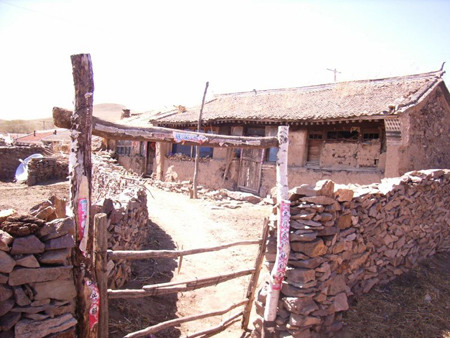
The poverty belt around Beijing and Tianjin has been a research topic for years, but the conditions there almost remain unchanged.
(Ecns.cn) – Six years ago, the Asian Development Bank (ADB) published a study of the poverty belt around Beijing and Tianjin. Yet as 2011 comes to a close, these impoverished counties are still failing to cash in on the growth of the two major metropolises, which has given rise to envy and dissatisfaction among local inhabitants.
On an intercity bus bound for Chicheng County of North China's Hebei Province, most of the passengers who boarded in Beijing have fallen asleep. However, they are soon jolted awake and forced to clutch their seats thanks to the pockmarked condition of the county road.
The journey is only 180 kilometers. Though not a long distance, it reflects the sad and astonishing fact that Beijing is still surrounded by a large number of poverty-stricken counties. The disparities between Beijing and Hebei continue to widen even now.
Early attempts to address the disparity, such as the "Capital Economic Circle," the "Economic Circle Surrounding Beijing" and the "Metropolitan Economic Circle," have apparently done little to change the situation. As Beijing builds itself into a world-class metropolis, some of the surrounding areas continue to live in a state of poverty.
So close, yet so far away
On August 17, 2005, the concept of a "poverty belt around Beijing and Tianjin" was first set forth in an ADB study on the socioeconomic development strategy of Hebei Province.
According to the study, the belt consisted of 32 counties, mostly to the north and northwest of Beijing and Tianjin, with an impoverished population of 2.7 million living in 3,798 villages. At that time, poverty was defined as an annual income of less than 625 yuan ($99), and the average urban income in Beijing was about 18,000 yuan a year, according to a report cited by the Southern News Network.
The situation has not changed much, and the contrast between Hebei's Chicheng County and Beijing's Yanqing District is as stark as ever.
On December 19, at midday, a wedding ceremony at the Xinhua Hotel attracted crowds of friends and relatives in Chicheng County. It also attracted over ten beggars wearing rags, all reaching out their hands for money, hoping to take advantage of the joyous occasion.
According to a local official, the number of beggars has been increasing rapidly in Chicheng in recent years. He remembers there were once more than 70 of them waiting outside the wedding site, causing embarrassment and irritation.
The scene was only the tip of the iceberg. By the end of 2010, there were 170 impoverished villages in Chicheng, with a population of nearly 85,000, about 34.6 percent of the total agricultural population in the county, revealed Li Guizhong, director of the local Poverty Relief Office.
Li said poverty this year is defined as annual income of less than 2,300 yuan ($364), but there are currently only four villages with annual incomes above the line in Chicheng. However, Beijing's Yanqing District, just across the road, is far better – the annual per capita income of Yanqing's Huapen Village, which neighbors Chicheng, was 8,500 yuan ($1,346) in 2010.
Limited autonomy in industrial restructuring
Zhangjiakou, a time-honored prefecture-level city north of Hebei and adjacent to Beijing, lags behind in its industrial restructuring process, and many complain it is the result of Beijing's regulation and control policy.
According to an official of the local Development and Reform Bureau, in the past there were many chemical fertilizer plants, paper mills, cement plants, textile mills, and gold and silver refineries in Zhangjiakou, but they were all closed down for causing too much pollution.
The official said it is never wrong to shut down firms that are heavy polluters, but the decision came too fast and Zhangjiakou was unable to find a back-up industry, and had no choice but to cooperate with Beijing's development plans.
However, even under the same policy, government subsidies and appropriations are quite different in Beijing than in Hebei. Chicheng's fiscal revenue was 630 million yuan ($99.7 million) in 2010, while the figure was 990 million yuan ($156.7 million) in Yanqing. But Chicheng's disposable financial resources were only 570 million yuan ($90.2 million) that year, while Yanqing had access to 6 billion yuan ($950 million).
This has largely limited the autonomy of local governments in Hebei while adjusting their industrial structure. Without new sources of income, they are facing ever greater financial challenges.
Seeking answers
Depending on Beijing's policy is obviously not the best alternative, said an official from the Zhangjiakou Development and Reform Bureau, who noted that Zhangjiakou has provided water to Beijing for years, which has already affected the local ecological environment.
For Chicheng, this is also true. Though Chicheng has contributed much to protecting and serving Beijing, it has benefitted little from its association with the modern and booming metropolis.
Many experts point out that setting up a "Capital Economic Circle" is mainly for the purpose of easing pressure on Beijing, while also providing more growth room for surrounding areas. The continued struggle by areas located outside the capital means the policy has so far failed.
To the many impoverished counties, the policy is a joke, as the incomes of local residents remain at nearly the same level while home prices surge. To address this issue, there is still much work to be done.

Copyright ©1999-2011 Chinanews.com. All rights reserved.
Reproduction in whole or in part without permission is prohibited.